Clematis Cardinal Rouge - a detailed description of the variety
Among the late hybrids with a powerful crown and long flowering, Clematis Cardinal Rouge is the most unpretentious and disease resistant. It was obtained in 1968 in France through a long selection. It was based on two varieties - Ville de Lyon and Pourpre Mat, from which the hybrid has absorbed all the best qualities.
- Description of the plant
- Landing features
- Seat selection
- Preparation of planting material
- Landing technology
- Care
- Watering
- Top dressing
- Mulching and loosening the soil
- Pruning
- Preparing for winter
- Reproduction methods
- Dividing the bush
- Layers
- Cuttings
- Diseases and pests
- Examples of use in landscape design
- Variety reviews
- Useful videos
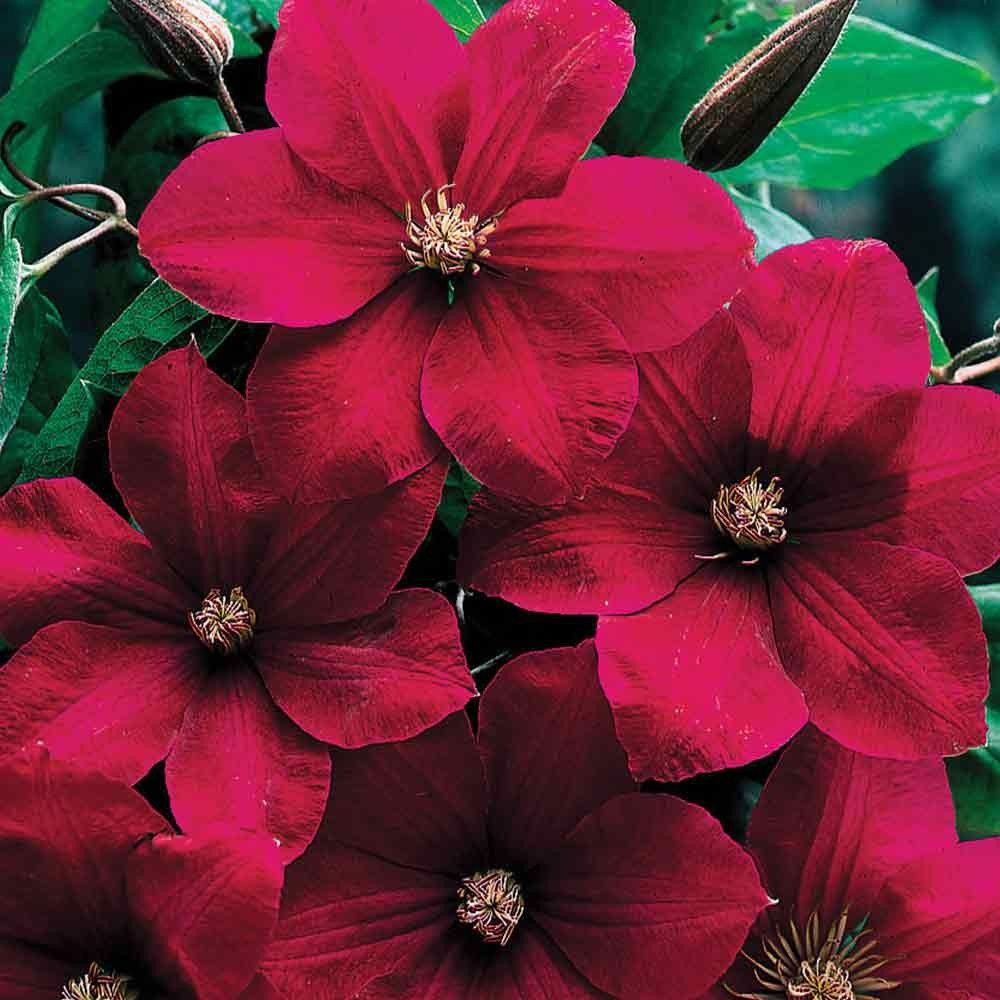
Clematis rouge cardinal description
Description of the plant
Variety Cardinal Rouge (lat.Cardinal Rouge) refers to large-flowered. With good care, clematis blooms profusely and for a long time - from mid-summer to early fall. Before wintering, the bush is cut off completely, as belonging to the III pruning group.
Shoots are long and thin, reaching 3 m in length. They are distinguished by a high growth rate - they can add up to 10 cm per day. The roots also grow rapidly, forming a powerful branched system already in the first year of planting. For this reason, the hybrid cannot be planted close to the wall - it is better to retreat 70-90 cm.
Leaves are compound, trifoliate, glossy on the front side. May change from light green to greenish brown as they grow. The petioles are long and tenacious. Liana is able to twine around any support and hold on to it tightly. The peculiarity of the hybrid is rapid growth. Shoots can add 10 cm per day.
The buds reach 16 cm in diameter, they are formed only on the shoots of the current year. Their color varies from dark purple to red-purple.
Landing features
Planting is carried out both in autumn and spring.
The landing time depends, first of all, on the climate. In southern latitudes, it is transferred to open ground in the fall, in October. Before frost, the seedlings will have time to harden and build up the necessary root mass.
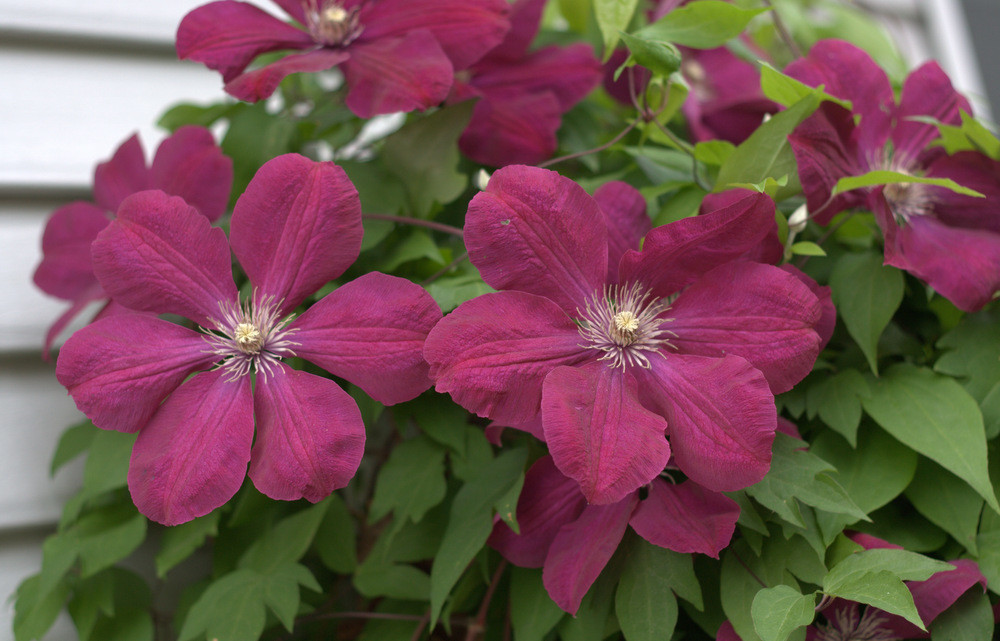
Clematis rouge cardinal
In more northern areas, it is better to plant clematis in the spring, when the threat of freezing temperatures goes away. Although the hybrid is considered one of the most winter-hardy, this does not apply to young plants. They are too weak to survive in the cold. Therefore, in the spring they will have more chances to settle down and grow.
Seat selection
This type of clematis prefers partial shade in contrast to other hybrids. In the open sun, the leaves will begin to dry and wither, and the buds will fall off. Under the shade of a tree, the plant will also not last long. The constant lack of light and humidity are faithful companions of a dangerous fungus to which all clematis are susceptible. Therefore, the ideal place for him is where the sun will be for half a day and partial shade from lunchtime.
This hybrid cannot be planted close to walls due to its highly branched root system. There must be enough room for roots, otherwise the plant will not be able to grow normally and release buds. This variety is ideal for arbors and decorative arches.
Some gardeners try to grow Cardinal Rouge in containers, but open field is preferred.
Preparation of planting material
Saplings are easy to buy in a store or in a special nursery. They acquire both cuttings with buds and plants with already regrown shoots and leaves.
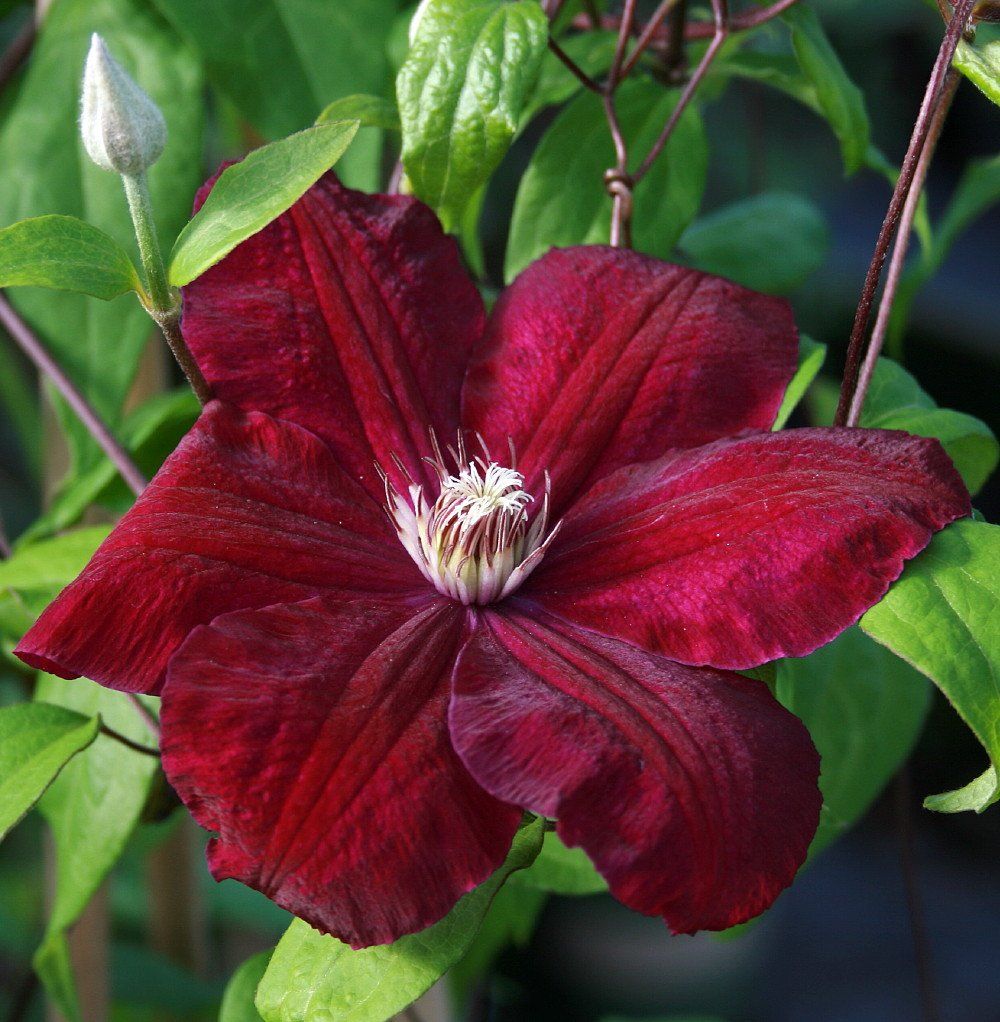
Clematis rouge cardinal photo
It is not recommended to buy seedlings with open roots - they rarely tolerate a transplant, but even with a favorable outcome, they remain painful and weakened. The roots must be covered (in a container), especially when mailing with long transport.
A healthy seedling looks fresh, it is green, smooth, without growths and spots on the shoots and leaves.
Before planting, the purchased material is always dipped with roots in a fungicide solution, then in a root formation enhancer. The exception is self-grown seedlings. Their roots have enough moisture, they do not need additional moisture and growth stimulation.
Landing technology
The clematis pit for Cardinal Rouge should be large - at least 70 cm in diameter, 70 cm deep. If groundwater passes close to the surface at the landing site, then the pit will be deeper in order to lay several layers of drainage on the bottom:
- stones;
- shards of clay;
- expanded clay;
- quartz sand;
- Styrofoam.
Nutrient soil is poured onto the drainage on top. For clematis, it should be as light, airy and neutral as possible. On acidic soils, these flowers do not grow for a long time - they begin to hurt, wither and die. We have to artificially deoxidize the soil with ash, dolomite flour and chalk, repeating this procedure every year.
The land for clematis is prepared according to the following scheme:
- leaf humus (60%);
- compost (20%);
- peat (10%);
- coarse sand (5%);
- ash (5%).
A sapling is placed on top of the ground, a support is placed next to it, all this is buried together with earth, slightly trampling it. The planting site is watered, and around the bush is mulched with fresh hay.
Important! The support must be dug in together with the seedling, so as not to damage its roots later. Clematis are very susceptible to any damage to the root system.
Care
The Cardinal Rouge hybrid is considered unpretentious; with good care, it can bloom for a long time and abundantly.
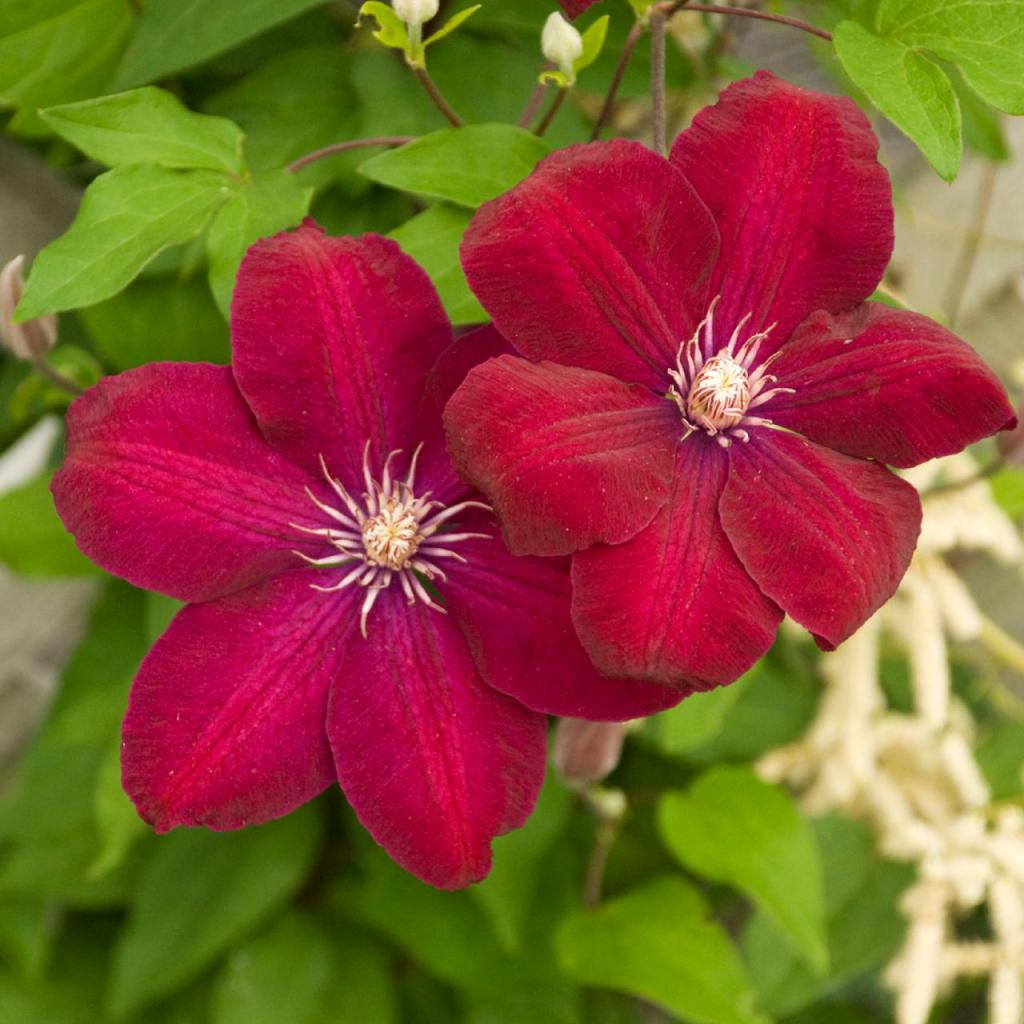
Rouge cardinal
Watering
Clematis should be watered quite often, especially in summer. Provided there is good drainage and an illuminated area, excess moisture will not stagnate in the roots. First-year seedlings require special attention. Their root system is just being formed, it is dangerous to dry out the bush during this period. Water for them must be settled or rainwater.
The watering rate for a young seedling is 10 liters, for an adult - 30 liters at a time. Some do not know that an adult bush needs to be watered, believing that the plant itself will draw out enough moisture from the soil for itself. This is not true.
Clematis must be watered in summer: adult bushes - 2 times a week, young ones - 3-4 times a week.
Top dressing
It is not necessary to fertilize the bush immediately after planting. The plant should have enough nutrients for the first year.
In the second year, in the spring, fertilizing begins.
- At the beginning of growth, after winter sleep, nitrogen must be added. Ammonium nitrate is better suited for this.
- In summer, before flowering, a lot of phosphorus and potassium are required. It is necessary to select complexes with precisely these mineral elements. It is better to feed the plant with ammophos or nitroammophos. Potassium nitrate will also be a good source of strength for lush and long flowering.
- By the end of summer, clematis needs trace elements, which are replenished with the help of organic matter. Dung or chicken droppings are great. The manure must be rotted, not fresh, otherwise the roots of clematis will immediately "burn". Pigeon droppings are good for a flower, but it is difficult to get it. Just 500 g is enough to saturate an adult shrub with nutrients after flowering.
- In the fall, the plant is also fed. It is better to add ready-made complexes at this time. For example, there is a good balanced mineral complex called "Autumn". In it, the substances necessary for clematis are optimally selected for healthy growth and the most successful wintering.
Used as fertilizer and folk remedies, time-tested and experience. For example, tea leaves or coffee grounds are simply poured under a bush or mixed with the top layer of soil. This will improve its structure, make it soft. Dried banana or orange peels have the same properties. When crushed, they serve as an excellent fertilizer.
They are fed with yeast dissolved in water. The best effect is given by yeast in herbal infusion. Meadow greens are cut into a barrel or bucket, filled with water, then yeast is added there. The mass is infused for a month, then the bush is watered with it. The water is simply poured out at the root, and the grass is laid out on the surface of the soil as mulch.
Mulching and loosening the soil
Mulching protects superficial roots from the sun and moisture loss. Throughout the summer, hay, grass (for example, from infusion), peat or sawdust are laid out under the bush. The latter are good only in the warm period; in winter they cannot be used for warming the roots.
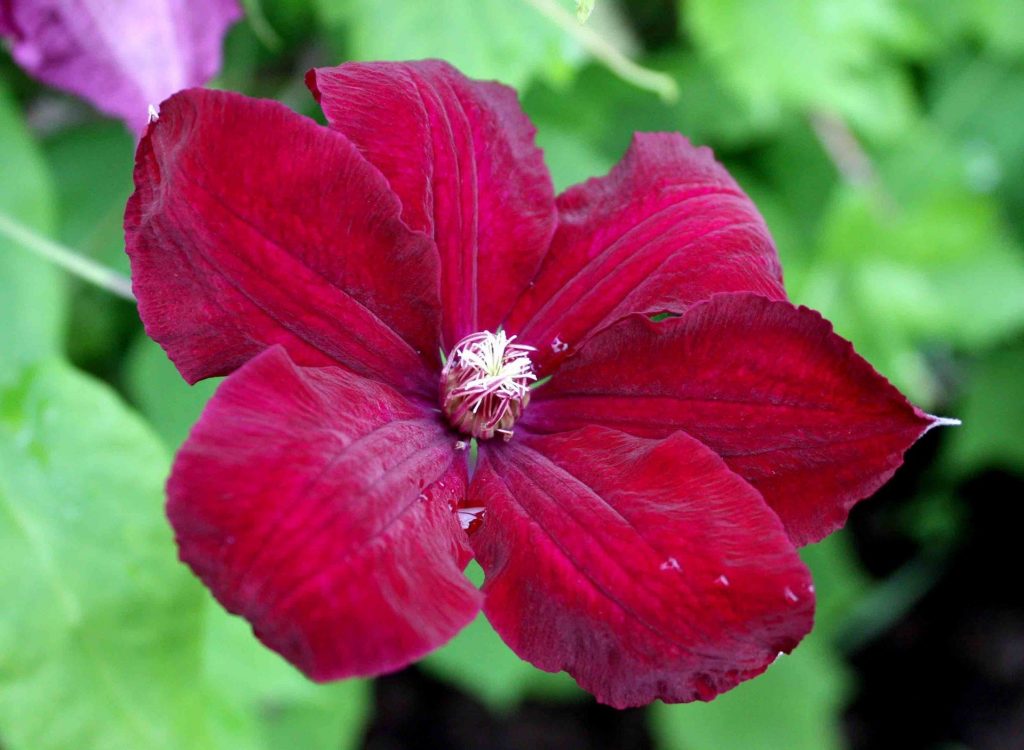
Clematis rouge cardinal description
It is necessary to loosen the ground regularly. Ideally, after every rain or watering. Roots need air, they choke on the heavy earth. The plant will begin to ache, lose leaves and buds. Therefore, the loosening procedure must be repeated more often. The main thing is not to damage the delicate roots.
As mulch, it is allowed to plant annual herbs under clematis bushes. Anything is suitable for this, but it is better to plant marigolds, calendula, spicy herbs - they scare away harmful insects. The roots will be protected from overheating and drying out, as well as from pests. After dying off, annuals release nutrients into the soil.
Pruning
If you do not carry out this procedure, clematis simply will not bloom.
The Cardinal Rouge variety belongs to the III pruning group. This is the simplest version of it, when in the fall the entire bush is cut off completely, leaving only the rudiments of shoots with 3-4 buds above the surface.
There is no point in leaving the shoots uncircumcised for the next year - the buds of this hybrid are tied only on young shoots.
Preparing for winter
The main preparation for winter is to reduce the concentration of nitrogen in fertilizers. The plant should not provoke the growth of green mass in late autumn. This will weaken it, prevent it from wintering normally. The second part of preparing for winter is proper pruning. It is necessary for lush flowering next year.
Before frosts, dry hay or straw, spruce branches or cut perennials are laid out around the bush. Then the plant is sprinkled over the foliage and covered with non-woven material. Some put a film on top, attaching stones around the edges, but then there is a risk of rotting the plant.
You can build a small greenhouse with planks or just put a large wooden box. Cover it on top with sponbond and film, attach it with bricks around the edges so that the shelter is not scattered by the wind. So, in the presence of snow, the plant will calmly withstand even -45 ° C.
It has even been noticed that the stronger the frost in winter, the more magnificently clematis will bloom next year.
Reproduction methods
The hybrid is easy to propagate in several ways. Each has features and secrets on which the success of the procedure depends. The procedure is best done in the spring when the plant is actively growing.
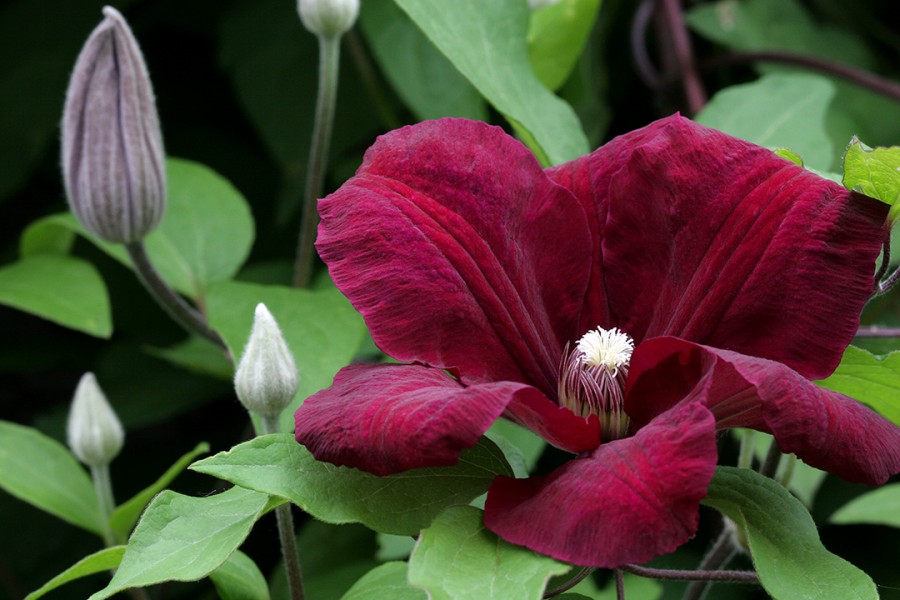
Clematis red cardinal
Dividing the bush
Old thickened bushes begin to bloom worse, get sick and die earlier if they are not rejuvenated. Dividing a bush is both reproduction and rejuvenation of the plant. At the same time, the bush is dug up, the earth is shaken off from the roots and separated with a sharp knife. Slices are sprinkled with activated carbon.
Separated bushes are placed in pre-prepared pits. The distance between them must be at least one meter. Landing is needed according to all the rules, with the placement of supports in the landing pit. At first, the seedlings are watered often - every 2 days. By the end of the season, when they have taken root, watering can be reduced.
Layers
A very simple and reliable breeding method.One of the vines is pulled to the side and bends down to the ground. All that remains for the gardener to do is to dig it into the ground, leaving the top on the surface. With regular watering, the cuttings take root in a month, and by the end of the season it is already an independent young plant.
However, it is better to separate the layers from the mother bush next year. It will be easier for him to overwinter in conjunction with the main adult plant. In the spring, when clematis grows, the layers can be separated and transplanted to a new permanent place.
Cuttings
It is better to cut the cuttings in the spring, when the sap flow has already begun. One vine can be divided into 3-4 cuttings, 3-4 buds each. They can be rooted in water or soil. The second option is preferable, so the plant does not experience unnecessary stress during transplantation.
A special rooting substrate is prepared - light and loose, as breathable as possible. Its composition is as follows:
- garden land;
- perlite;
- vermiculite;
- Styrofoam;
- coarse sand.
In such a substrate at a temperature of +27 ° C, the cutting will take root in 2-3 weeks. As soon as new young leaves appear, the seedling is ready for transplanting into the ground. For the first year, it is better to place it in a greenhouse on the site, and then, after winter, plant it in a permanent open place.
Diseases and pests
The Cardinal Rouge hybrid is not very resistant to diseases, especially fungal ones. Insect pests also annoy him. However, with proper prevention and careful care, problems can be avoided.
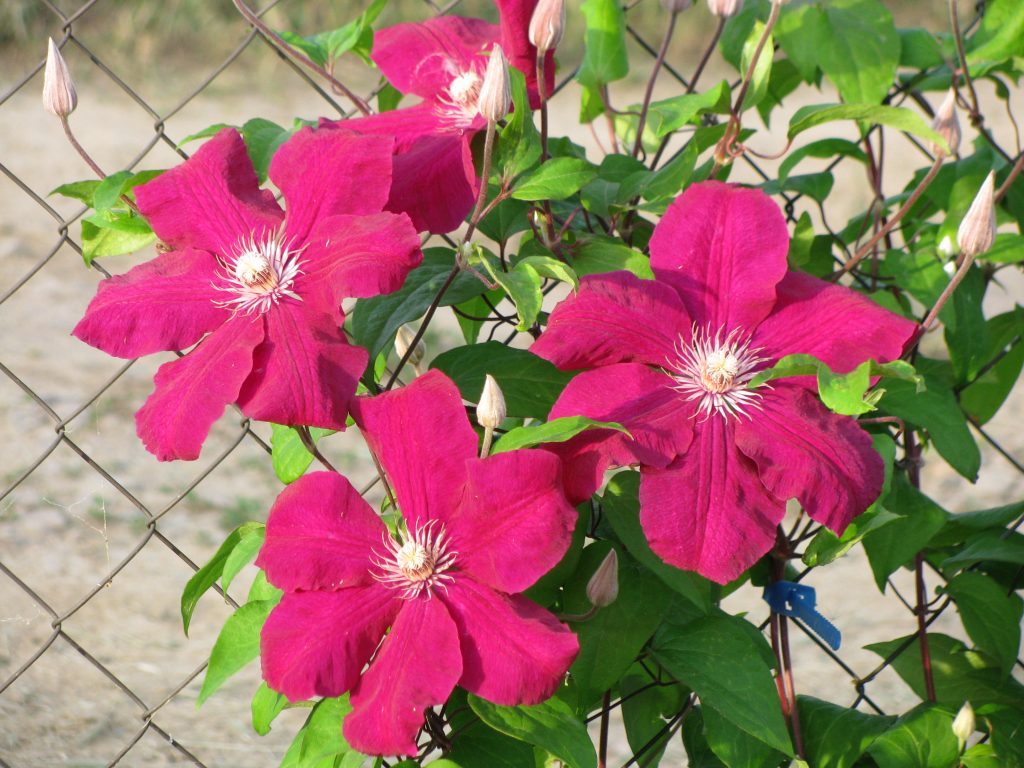
Clematis rouge cardinal planting and care
Fusarium. The lowest, oldest leaves, which are closer to the ground, are affected first. They wither, turn yellow and fall off. All affected greens are collected and burned, the plant is sprayed with Quadris, Merpan preparations. In the future, they monitor the irrigation and lighting regime so that the soil does not remain constantly wet.
Wilt. The tops of young shoots wilt, then the whole plant is affected. Disease shoots are cut and burned. The bush is sprayed with foundation, potassium permanganate, copper sulfate with the addition of soap foam. The best prevention is the correct watering regime.
Spider mite. The insect is easy to spot on the stems, especially its webs. The pest sucks juices from young leaves, weakening the plant. The best remedy is Anti-tick. Also drugs Aktara, Skor.
Fly. It forms necrotic spots on the leaves, and the larvae gnaw through the passages inside them. For the fight use insecticides Lightning, Commander, Tanrek.
Thrips. Insects and their larvae drink juices from leaves and shoots, the plant turns yellow, shedding buds. Insecticides Paton Super, Actellik, Decis Profi help. At the time of processing, it is necessary to pluck all the buds.
Nematodes. These microscopic worms live in the roots. Numerous tubers are formed on them, clematis begins to lag behind in development, withers and dies. It is impossible to cure the plant. It should be dug up and destroyed, and the ground under it should be carefully treated with strong insecticides.
Examples of use in landscape design
The Cardinal Rouge variety is excellent for braiding arbors and arches, because it grows quickly and stretches up to 3.5 meters. They planted it near the porch to decorate the entrance to the house. This clematis is also good in joint compositions with roses and grapes.
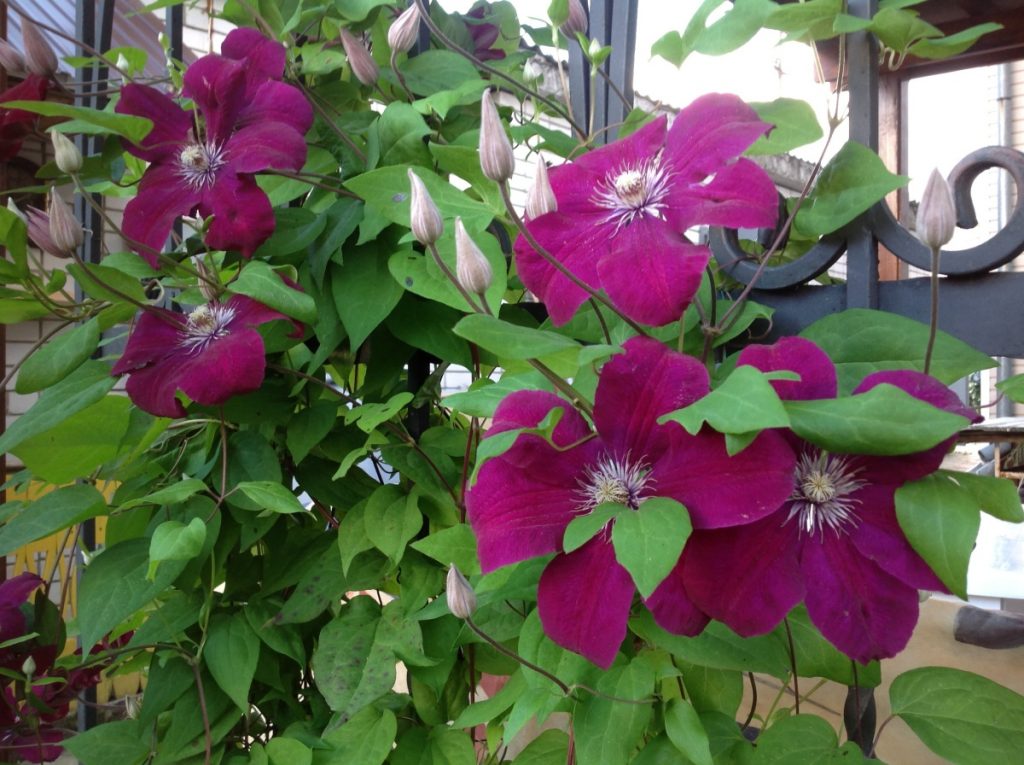
Clematis rouge cardinal trimming band
Climbing roses, hydrangeas, decorative grapes and climbing honeysuckle and other plants are excellent neighbors for this hybrid. Having picked up different types and varieties of flowers, you can achieve continuous cascading flowering in your garden. The large-flowered Cardinal Rouge will always adorn a lively composition.
Variety reviews
Cardinal Rouge is very popular with gardeners and is loved for its unpretentiousness and frost resistance. Its qualities are appreciated not only by domestic, but also by foreign experts. The variety received a gold medal at an exhibition of garden plants in Holland.
The hybrid is suitable for growing in any latitude, while it is not too demanding to care for.With proper prevention, diseases and pests are not afraid of him, and competent feeding will ensure the longest flowering. The variety has the simplest pruning group, which makes it much easier to care for for novice gardeners.

